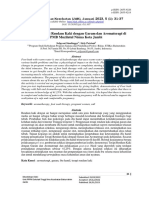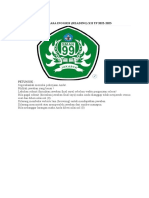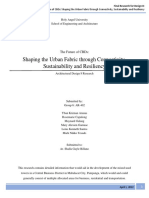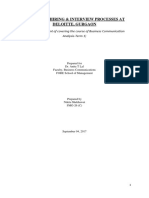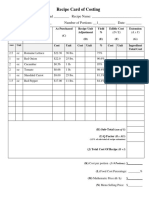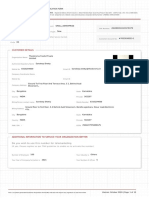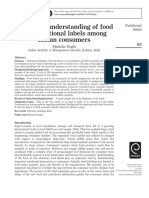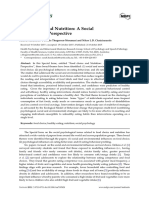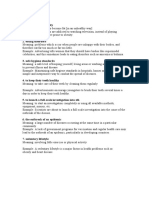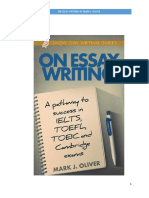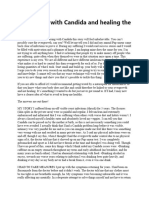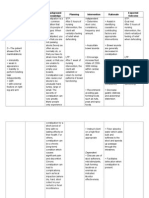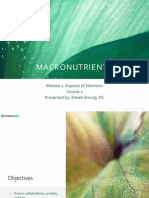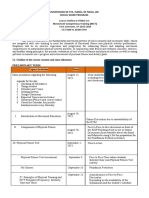Capturing Health and Eating Status Through A Nutri
Capturing Health and Eating Status Through A Nutri
Uploaded by
Aniket VermaCopyright:
Available Formats
Capturing Health and Eating Status Through A Nutri
Capturing Health and Eating Status Through A Nutri
Uploaded by
Aniket VermaOriginal Title
Copyright
Available Formats
Share this document
Did you find this document useful?
Is this content inappropriate?
Copyright:
Available Formats
Capturing Health and Eating Status Through A Nutri
Capturing Health and Eating Status Through A Nutri
Uploaded by
Aniket VermaCopyright:
Available Formats
San-Cristobal et al.
International Journal of Behavioral Nutrition and Physical Activity
(2017) 14:168
DOI 10.1186/s12966-017-0624-6
RESEARCH Open Access
Capturing health and eating status through
a nutritional perception screening
questionnaire (NPSQ9) in a randomised
internet-based personalised nutrition
intervention: the Food4Me study
Rodrigo San-Cristobal1, Santiago Navas-Carretero1,2*, Carlos Celis-Morales3, Katherine M. Livingstone3,
Barbara Stewart-Knox4, Audrey Rankin5, Anna L. Macready6, Rosalind Fallaize6, Clare B. O’Donovan7,
Hannah Forster7, Clara Woolhead7, Marianne C. Walsh7, Christina P. Lambrinou8, George Moschonis8,
Yannis Manios8, Miroslaw Jarosz9, Hannelore Daniel10, Eileen R. Gibney7, Lorraine Brennan7,
Thomas E. Gundersen11, Christian A. Drevon12, Mike Gibney7, Cyril F. M. Marsaux13, Wim H. M. Saris13,
Julie A. Lovegrove6, Lynn J. Frewer14, John C. Mathers3, J. Alfredo Martinez1,2,15,16
and on behalf of the Food4Me Study
Abstract
Background: National guidelines emphasize healthy eating to promote wellbeing and prevention of non-
communicable diseases. The perceived healthiness of food is determined by many factors affecting food intake. A
positive perception of healthy eating has been shown to be associated with greater diet quality. Internet-based
methodologies allow contact with large populations. Our present study aims to design and evaluate a short
nutritional perception questionnaire, to be used as a screening tool for assessing nutritional status, and to predict
an optimal level of personalisation in nutritional advice delivered via the Internet.
Methods: Data from all participants who were screened and then enrolled into the Food4Me proof-of-principle
study (n = 2369) were used to determine the optimal items for inclusion in a novel screening tool, the Nutritional
Perception Screening Questionnaire-9 (NPSQ9). Exploratory and confirmatory factor analyses were performed on
anthropometric and biochemical data and on dietary indices acquired from participants who had completed the
Food4Me dietary intervention (n = 1153). Baseline and intervention data were analysed using linear regression and
linear mixed regression, respectively.
(Continued on next page)
* Correspondence: snavas@unav.es
1
Centre for Nutrition Research, Department of Nutrition, Food Science and
Physiology, University of Navarra, C/Irunlarrea, 1, 31008 Pamplona, Spain
2
CIBER Fisiopatología Obesidad y Nutrición (CIBERobn), Instituto de Salud
Carlos III, 28023 Madrid, Spain
Full list of author information is available at the end of the article
© The Author(s). 2017 Open Access This article is distributed under the terms of the Creative Commons Attribution 4.0
International License (http://creativecommons.org/licenses/by/4.0/), which permits unrestricted use, distribution, and
reproduction in any medium, provided you give appropriate credit to the original author(s) and the source, provide a link to
the Creative Commons license, and indicate if changes were made. The Creative Commons Public Domain Dedication waiver
(http://creativecommons.org/publicdomain/zero/1.0/) applies to the data made available in this article, unless otherwise stated.
Content courtesy of Springer Nature, terms of use apply. Rights reserved.
San-Cristobal et al. International Journal of Behavioral Nutrition and Physical Activity (2017) 14:168 Page 2 of 12
(Continued from previous page)
Results: A final model with 9 NPSQ items was validated against the dietary intervention data. NPSQ9 scores were
inversely associated with BMI (β = −0.181, p < 0.001) and waist circumference (Β = −0.155, p < 0.001), and positively
associated with total carotenoids (β = 0.198, p < 0.001), omega-3 fatty acid index (β = 0.155, p < 0.001), Healthy
Eating Index (HEI) (β = 0.299, p < 0.001) and Mediterranean Diet Score (MDS) (β = 0. 279, p < 0.001). Findings from
the longitudinal intervention study showed a greater reduction in BMI and improved dietary indices among
participants with lower NPSQ9 scores.
Conclusions: Healthy eating perceptions and dietary habits captured by the NPSQ9 score, based on nine questionnaire
items, were associated with reduced body weight and improved diet quality. Likewise, participants with a lower score
achieved greater health improvements than those with higher scores, in response to personalised advice, suggesting that
NPSQ9 may be used for early evaluation of nutritional status and to tailor nutritional advice.
Trial registration: NCT01530139.
Keywords: Food4Me, Personalised nutrition, Survey, Healthy eating index, Mediterranean diet score, NPSQ9,
Nutritional status
Background food choices, including a reduced energy intake where
A number of national strategies and programs focus on appropriate, during a dietary intervention with persona-
improving lifestyle and dietary habits for the prevention lised nutritional advice [13, 14].
of non-communicable chronic diseases [1], especially Development of tools to assess health status has
those related to weight management [2, 3]. However, the played an important role in health behaviour research
perceived benefit of consuming certain foods is influ- [15]. The relationship between wellbeing and healthy
enced by multiple individual factors, which may alter eating is well established, which is the reason why many
eating habits and dietary patterns. Identification of these psychological and public health studies have tried to
factors and dietary patterns is an important challenge develop questionnaires aiming to collect information on
for the promotion of well-being and public health [4, 5]. complex issues like eating behaviour related to the
Identification of barriers to the consumption of healthy development of chronic diseases such as obesity,
foods is imperative to the design of effective behaviour diabetes, and cardiovascular events [16, 17]. These
change interventions and policies [6]. Moreover, infor- questionnaires require the use of representative data
mation on barriers to healthy eating will help identify and sufficient accuracy before being used as early
food-related perceptions that have the potential to nega- detection tools.
tively impact on dietary choices [7]. The current development of worldwide internet-based
Perception of food healthiness is determined by communications has highlighted the need for short and
numerous factors such as conventional and unconven- applicable tools for the screening of large populations
tional beliefs [4, 6], as well as consciousness/knowledge [18]. The use of Internet-based platforms allows contact
of food composition [8]. Such perceptions may affect with large numbers of individuals with a good cost
attitudes towards foods consumption, resulting in under- effectiveness [19], however such questionnaires would
or over-eating and causing unhealthy changes in body need to be tested in different settings and with large and
weight [8]. Previous studies have indicated positive asso- heterogeneous populations. The present study was a
ciations between perception of healthy food intake and cross-sectional and longitudinal analysis intended to
diet quality [9–11]. A preceding study on dietary design and validate a short nutritional perception
patterns in a Spanish cohort showed that participants questionnaire. It is anticipated that this screening tool
who presented with “prudent” or “healthy” dietary may be used by health professionals to assess percep-
patterns reported greater proportions of positive percep- tions of eating behaviour and health status with the aim
tions of healthy eating than those who exhibited a of predicting the optimal level of personalisation in
“Western” or “compensatory” dietary patterns [5]. nutritional advice via the internet.
Similarly, the perception of healthy eating has been pre-
sented by some authors as a plausible predictor of Methods
behavioural intentions regarding food choices [12]. Such Study population and study design
evidence suggests that a maintained positive perception The Food4Me study followed all required ethical standards,
of healthy intake, alongside other perceived values, including the CONSORT guidelines (Additional file 1).
might contribute to the adoption of healthy habits and Participants in the follow-up Nutritional Perception
Content courtesy of Springer Nature, terms of use apply. Rights reserved.
San-Cristobal et al. International Journal of Behavioral Nutrition and Physical Activity (2017) 14:168 Page 3 of 12
Screening Questionnaire-9 (NPSQ9) design were enrolled based on dietary data; Level 2 – personalised advice based
from the Food4Me study, which was a randomised con- on dietary and phenotypic data; and Level 3 – personalised
trolled intervention trial designed to assess the effect of per- advice based on dietary, phenotypic, and genotypic data.
sonalised nutrition advice on health-related behaviours For the analysis of the effects of personalised nutrition ad-
across seven European countries [20]. Participants who vice, volunteers from Levels 1, 2, and 3, were pooled to
signed up on the Food4Me webpage (http://www.food4 evaluate the effects of personalising the nutritional advice,
me.org) and completed the initial screening processes were without taking into account the type of feedback provided.
selected (n = 2369) for inclusion in the NPSQ9 design.
These processes consisted of signing two informed consent
forms if inclusion criteria for taking part in the Food4Me Item selection
study were met [20], and providing information by answer- Data obtained from the questionnaire, specifically
ing the screening questionnaires (Table 1), on aspects re- designed within the Food4Me study, and related to diet-
garding socio-demographics, medical history, lifestyle and ary habits, health perception, eating perception, and
dietary habits, health and eating self-perception, as well as nutrition self-efficacy were used for the analyses. This
responses to a validated Food Frequency Questionnaire questionnaire contained Likert scale questions related to
(FFQ) [21, 22]. Volunteers selected for inclusion in the Nutrition Self-efficacy [23], Health locus of control [24],
intervention and who completed the questionnaires at Self-report Habit Index [25, 26], and Dietary food choice/
baseline and at 6 months (n = 1153), were used for the sub- habits (Additional file 2: Table S1).
sequent validation study and for association analyses with Socio-demographic questions, self-reported height and
different dietary indices (Fig. 1). During the study, the vol- weight [27], the validated Food4Me FFQ [21, 22, 28],
unteers were randomly assigned to one of four intervention and biochemical values of dried blood spots [29], were
groups receiving different types of personalised nutrition analysed for associations with the scores obtained from
advice: Level 0 – control group – conventional non- the screening stage. These questionnaire items were
personalised nutrition advice; Level 1 – personalised advice coded and used to create a reduced aggregate score.
Table 1 Characteristics of overall sample and by country
Overall By country
Germany Greece Ireland Netherlands Poland Spain United Kingdom
n (n of females) 2369 (1534) 343 (231) 262 (180) 238 (145) 398 (231) 253 (190) 634 (386) 241 (171)
Age (years) 40 ± 13 44 ± 14 38 ± 12 39 ± 13 48 ± 14 36 ± 13 38 ± 10 37 ± 13
Ethnicity
Asian 11 (0.5%) – – – 3 (0.8%) – – 8 (3.3%)
Black 2 (0.1%) 2 (0.6%) – – – – – –
Mixed 30 (1.3%) 5 (1.5%) – 4 (1.7%) 5 (1.3%) – 8 (1.3%) 8 (3.3%)
Chinese 1 (0.0%) – – – – – – 1 (0.4%)
White 2305 (97.3%) 332 (96.8%) 260 (99.2%) 234 (98.3%) 385 (96.7%) 253 (100.0%) 624 (98.4%) 217 (90.0%)
Other 20 (0.8%) 4 (1.2%) 2 (0.8%) – 5 (1.3%) – 2 (0.3%) 7 (2.9%)
BMI (kg/m2) 25.2 ± 4.7 24.3 ± 3.7 26.6 ± 5.8 25.4 ± 4.7 25.0 ± 4.2 24.6 ± 4.8 25.7 ± 4.8 24.9 ± 4.7
Weight status (by BMI)
Under-weight 56 (2.4%) 8 (2.3%) 5 (1.9%) 8 (3.4%) 10 (2.5%) 11 (4.4%) 11 (1.7%) 3 (1.2%)
Normal weight 1247 (52.6%) 206 (60.1%) 115 (43.9%) 123 (51.7%) 214 (53.8%) 139 (54.9%) 308 (48.6%) 142 (58.9%)
Overweight 743 (30.8%) 97 (28.3%) 90 (34.4%) 65 (27.3%) 128 (32.2%) 68 (26.9%) 213 (33.6%) 71 (29.5%)
Obese 334 (14.1%) 32 (9.3%) 52 (19.9%) 42 (17.7%) 46 (11.6%) 35 (13.8%) 102 (16.1%) 25 (10.4%)
Energy intake reported (kcal) 2633 ± 775 2509 ± 678 2519 ± 744 2779 ± 772 2723 ± 760 2593 ± 779 2674 ± 816 2571 ± 805
Physical activity level (AU) 1.51 ± 0.10 1.50 ± 0.08 1.50 ± 0.11 1.53 ± 0.09 1.54 ± 0.10 1.50 ± 0.11 1.50 ± 0.10 1.54 ± 0.11
Smoke habit
Non-smoker 1411 (59.6%) 201 (58.6%) 132 (50.4%) 164 (68.9%) 202 (50.8%) 197 (77.9%) 328 (51.7%) 187 (77.6%)
Ex-smoker 671 (28.3%) 112 (32.7%) 53 (20.2%) 57 (24.0%) 169 (42.5%) 38 (15.0%) 200 (31.6%) 42 (17.4%)
Current smoker 287 (12.1%) 30 (8.8%) 77 (29.4%) 17 (7.1%) 27 (6.8%) 18 (7.1%) 106 (16.7%) 12 (5.0%)
BMI Body Mass Index, AU Arbitrary Units
Content courtesy of Springer Nature, terms of use apply. Rights reserved.
San-Cristobal et al. International Journal of Behavioral Nutrition and Physical Activity (2017) 14:168 Page 4 of 12
Fig. 1 Flowchart for participant selection in the present study
Dietary assessment considered inadequate, while for those nutrients in which
For participants included in the randomization interven- excessive intake may also be considered inadequate, over-
tion study, diet quality indices were calculated at baseline consumption was also taken into account. The Mean
(t0), 3 months (t3) and 6 months (t6), to assess the effect Adequacy Ratio (MAR) was a measure of overall diet
of personalised nutrition advice on dietary intake. Healthy adequacy including the mean of all the NAR components.
Eating Index-2010 (HEI-2010) was calculated as described For both NAR and MAR a score of 100% represented the
by Guenther et al. [30] according to consumption of food ideal adequacy of intake reported, showing neither
groups estimated using the FFQ. The Mediterranean Diet reduced nor excessive consumption.
Score (MDS) was calculated using the PREDIMED 14-
item screening tool [31]. Finally, Nutrient Adequacy Ratio Chemical validation of intakes of fatty acids and of
(NAR), as described elsewhere [32], was estimated for the carotenoids using analysis of dried blood spots
following nutrients: protein, carbohydrates, total fat, Dietary fatty acid markers were determined via gas liquid
saturated fat, monounsaturated fatty acids (MUFA), poly- chromatography combined with flame ionisation detection
unsaturated fatty acids (PUFA), omega-3 fatty acids, salt, (GLC-FID) by Vitas Ltd. (www.vitas.no) as described
fiber, calcium, iron, vitamin A, folate, thiamine, riboflavin, previously [34]. Carotenoids were determined using high
vitamin B12, and vitamin C, after the personalised performance liquid chromatography with UV detection
nutrition intervention [33]. The NAR was specifically (HPLC-UV) on dried blood spots (DBS) cards with an
calculated for each nutrient, and the recommended intake appropriate stabilizer impregnated onto the DBS paper [35].
values established in the intervention were used as the
reference. Subsequently, the reported intake of each nutri- Statistical analyses
ent was computed as a percentage of the corresponding To determine items for inclusion in the final NPSQ9
reference value, establishing levels of attainment. For scale, the questions previously coded (Additional file 2:
some specific nutrients only under-consumption was Table S1) were analysed through an exploratory factor
Content courtesy of Springer Nature, terms of use apply. Rights reserved.
San-Cristobal et al. International Journal of Behavioral Nutrition and Physical Activity (2017) 14:168 Page 5 of 12
analysis with the “least squares estimation” method and software (Stata IC version 12.0, StataCorp, College
“varimax rotation”, to include the maximum amount of Station, TX, USA), and p values lower than 0.05 were
variance from the categorical variables. considered significant.
Secondly, to test the suitability of the data used for the
factor analysis, the Kaiser-Meyer-Olkin Criterion [36] and Results
Bartlett’s test of sphericity [37] were performed. Scree plot Descriptive statistics among recruiting centres showed dif-
and Eigen values higher than 1 were used for the selection ferences regarding population characteristics (Table 1).
of the factors to be included in the NPSQ9. By this Exploratory factor analysis using an iterative process,
method it was possible to collect the highest proportion of carried out on the 2369 volunteers and including 22
variance. For each factor, a step-wise selection (removing questions from the screening questionnaire (Table S1, in
and rerunning the analysis) of the items was applied. Sub- Additional file 2), revealed a total of nine items with factor
sequently, the items presenting a factor loading greater loadings higher than 0.3 after varimax rotation (Table 2).
than 0.3 for the model were selected and included in the The Kaiser-Meyer-Olkin Criterion was 0.83 and Bartlett’s
aggregate score, which was calculated by summing the test of sphericity was highly significant (p < 0.001), indicat-
coded values of each question, thus providing a plausible ing suitability of the results.
range of scores from 0 to 30 (NPSQ9 score). The nine items were aggregated into two groups (or
The internal reliability of the score items was evaluated factors) that were named “Management” and “Perception
by a Cronbach alpha analysis. Finally, a confirmatory fac- & Habits” respectively, to reflect the items included in
tor analysis (CFA) was performed by means of structural each. The “Management” factor included items reflecting
equation modelling (SEM). To identify correlated unique- the self-reported capacity of the volunteers to select
ness in the obtained factor model, modification of indices healthy foods, and the effort required to achieve healthy
was checked, and goodness-of-fit indices were estimated. eating habits. The “Perception & Habits” factor included
The resulting NPSQ9 score was used in the Food4Me par- items related to the effort of selecting healthy foods, and
ticipants who had been randomised to the personalised one item involving substitution of meals with snacks.
nutrition intervention (Fig. 1), in order to validate the The correlation between the estimated factor scores and
results obtained with the exploratory analysis performed factors (factor determinacies coefficient) were higher
in the screening population. Model robustness was also than 0.978 for both factors. The analysis of internal
tested by applying the model in different subgroups classi- consistency showed an acceptable Cronbach’s alpha of
fied by sex and age (<45 years or ≥45 years) from the 0.792 for overall items, whereas the alpha values for each
randomised volunteers. factor were 0.875 and 0.732, respectively (Table 2).
A linear regression model adjusted for continuous var-
Table 2 Exploratory factor analysis for questionnaire
iables (age, and physical activity) and categorical vari-
item selection
ables (sex, country, socio-economic status and smoking
Factor
habits) was performed to test the association between loadings
the NPSQ9 score and anthropometrical characteristics,
Factor 1: Management
biochemical values, and diet quality indices (MDS and
I Can Manage To Stick To Healthy Foods:
HEI) in the screening population. Furthermore, linear
mixed regression models, adjusted also by age, sex, Even If I Need A Long Time To Develop The 0.775
Necessary Routines
country, physical activity, socio-economic status and
Even If I Have To Try Several Times Until It Works 0.819
smoking habits, were used to analyse potential trends in
variables categorised by tertiles of NSPQ9 score within Even If I Have To Rethink My Entire Way Of Nutrition 0.791
the participants randomised in the Food4Me interven- Even If I Do Not Receive A Great Deal Of Support 0.669
tion. To analyse the effect of personalised nutrition From Others When Making My First Attempts
advice during the intervention on the obtained NPSQ9 Even If I Have To Make A Detailed Plan 0.725
score, time-point and level of personalised advice inter- Cronbach’s alpha = 0.875
actions were included in the previously described mixed Factor 2: Perception & Habits
models for estimating the variation of each dependent
Eating Healthily Is Something I Do Frequently 0.649
variable on each tertile of the NPSQ9 score.
I Eat Healthily Without Having To Consciously Think 0.759
For descriptive analyses, differences between groups About It
were assessed by chi-square for categorical variables,
Eating Healthily Is Something I Don’t Have To Think 0.777
and by analysis of variance (ANOVA) adjusted for age, About Doing
sex, country, physical activity, socio-economic status and
Do You Skip Meals And Replace Them With Snacks? 0.311
smoking habits for continuous variables. All statistical
Cronbach’s alpha = 0.732
analyses were performed using STATA statistical
Content courtesy of Springer Nature, terms of use apply. Rights reserved.
San-Cristobal et al. International Journal of Behavioral Nutrition and Physical Activity (2017) 14:168 Page 6 of 12
Furthermore, results obtained in the exploratory ana- positive association with β-values of 0.2 (p < 0.001) and
lyses were confirmed by the CFA with the corresponding 0.16 (p < 0.001) for total carotenoids and omega acid-3
items (Figure S1, in Additional file 3). The goodness-of- fatty index, respectively, as well as 0.3 (p < 0.001) and
fit values for the two factors model after the inclusion of 0.28 (p < 0.001) for HEI and MDS, respectively.
four pairwise correlated errors showed acceptable ranges The trends during the intervention study (Table 4)
over the whole screening sample: RMSEA (0.037; 90% showed significant reduction in BMI, waist circumference,
CI: 0.029–0.044), CFI (0.992). When the resulting model plasma concentrations of glucose, cholesterol, total carot-
was applied to the sample of randomised volunteers, the enoids, and MAR, whereas omega-3 fatty acid index, HEI
results exhibited a satisfactory value for goodness of fit: and MDS were enhanced during the intervention. Differ-
RMSEA (0.031; 90% CI: 0.018–0.043), CFI (0.994). These ences in trends between tertiles 1 and 2 were observed in
results were also consistent when the model was carried waist circumference and plasma glucose, whereas total
out in categorised subsamples for sex and age: RMSEA carotenoids showed significant differences between tertiles
(0.028; 90% CI: 0.012–0.040), CFI (0.994) and RMSEA 1 and 3. Furthermore, HEI and MAR exhibited differences
(0.032; 90% CI: 0.019–0.044), CFI (0.992), respectively. in trends between the higher and lower tertile (Table 4).
Differences in the screening sample characteristics Despite the differences in trends during the intervention,
were observed when volunteers were categorised into the participants in tertile 3 maintained lower BMI and
tertiles of NPSQ9 score (Table 3). Lower BMI values waist circumference, and higher levels of carotenoids and
were observed in volunteers with a high NPSQ9 score, of omega-3 fatty acid index in blood, along with higher
and physical activity level was lower for the volunteers scores for HEI and MDS.
in the first tertile. Regarding food consumption, the indi- The effect of personalised nutrition advice on anthropo-
viduals ranked in the first tertile reported greater energy metrical and dietary quality is shown in Fig. 3. Interestingly,
intake and higher intake of sweets & snacks, whereas a significant reduction in BMI was found for participants
there was an increased intake of cereal, egg, fruit, and with low NPSQ9 scores receiving personalised advice as
vegetables in the upper tertiles. An association study compared to the control group (only receiving general
within the randomised participants was carried out to advice) at t3 (Δt0-t3: β = −0.23, 95%CI = −0.43 to
evaluate previous results obtained at baseline on the −0.03, ρ = 0.025) and t6 (Δt0-t6: β = −0.27, 95%CI =
anthropometrical, biochemical and diet quality indices −0.52 to −0.02, ρ = 0.038). Furthermore, significant
(Fig. 2). Negative relationships were found for anthropo- effects were observed for the diet quality indices: an
metrical variables, showing β-values of −0.18 for BMI (p increase for HEI at short-term, 3 months (Δt0-t3: β =
< 0.001) and −0.16 (p < 0.001) for waist circumference, 2.81, 95%CI = 1.06 to 4.66, ρ = 0.002), and also for
whereas biochemical and dietary indices showed a MDS at both short and long-term, 6 months (Δt0-t3:
Table 3 Dietary characteristics of screening sample by Nutritional Perception Screening Questionnaire-9 (NPSQ9) tertiles
Tertile 1 (Low) Tertile 2 (Medium) Tertile 3 (High) ρ† ρ‡
(Score 4–19) (Score 20–23) (Score 24–30)
n (n of women) 934 (478) 805 (546) 630 (506) 0.005§
Age (years) 40 ± 12 41 ± 14 40 ± 13 0.069 0.408
Physical activity level (AU) 1.49 ± 0.10a 1.52 ± 0.10b 1.53 ± 0.10b <0.001 <0.001
2 a b c
BMI (kg/m ) 26.4 ± 5.2 25.0 ± 4.5 23.9 ± 3.8 <0.001 <0.001
Energy intake reported (kcal/day) 2723 ± 801a 2571 ± 733b 2577 ± 775b <0.001 <0.001
a b b
Cereal (g/day) 42.9 ± 72.4 58.4 ± 104.4 64.9 ± 91.6 <0.001 <0.001
Dairy products (g/day) 360.9 ± 254.6 374.2 ± 285.4 385.2 ± 284.3 0.540 0.303
a a b
Eggs (g/day) 32.3 ± 37.9 30.9 ± 32.4 37.5 ± 49.2 0.012 0.013
Fats & Spreads (g/day) 21.2 ± 17.3 19.8 ± 14.9 20.3 ± 18.8 0.236 0.636
Fruit (g/day) 257.2 ± 237.6a 320.1 ± 248.6b 380.3 ± 301.4c <0.001 <0.001
Meat & Fish (g/day) 201.9 ± 119.4 187.0 ± 116.2 199.6 ± 139.8 0.358 0.476
Soups & sauces (g/day) 94.7 ± 76.4 97.8 ± 79.3 97.6 ± 88.1 0.082 0.051
Sweets & snacks (g/day) 121.3 ± 93.9a 100.1 ± 83.1b 82.0 ± 69.7c <0.001 <0.001
Vegetables (g/day) 188.1 ± 117.4a 229.1 ± 163.6b 282.6 ± 186.5c <0.001 <0.001
†
BMI Body Mass Index, AU Arbitrary Units. ANOVA for least squared values adjusted by age, sex, country, smoking habits, and physical activity with Bonferroni
post-hoc expressed by superscript letters; differences in letters show differences between groups with p-value < 0.05. §p-value for Chi-square test of distribution.
‡
p-value for linear trend
Content courtesy of Springer Nature, terms of use apply. Rights reserved.
San-Cristobal et al. International Journal of Behavioral Nutrition and Physical Activity (2017) 14:168 Page 7 of 12
Fig. 2 Association between Nutritional Perception Screening Questionnaire-9 (NPSQ9) Score with BMI, HEI score, total carotenoids in blood and
Omega-3 fatty acid index in blood. All associations were highly significant (p < 0.001)
β = 0.33, 95%CI = 0.01 to 0.65, ρ = 0.045; Δt0-t6: β = self-perception questions. Despite the numerous question-
0.47, 95%CI = 0.13 to 0.81, ρ = 0.007; respectively). naires developed in the last years, the combination of aware-
ness items with the capacity of predicting health and dietary
Discussion outcomes has not been properly addressed so far [38–40].
The main novelty of this study was the development of a This tool used items from the Food4Me screening
screening tool based on health and eating status, through questionnaire, which was validated to collect
Table 4 Linear trend prediction through follow-up (0, 3 and 6 months) for changes by NPSQ9 tertiles of randomised volunteers
Tertile 1 (Low) Tertile 2 (Medium) Tertile 3 (High) ρ† ρ‡
Score 7–19 20–23 24–30 – –
n (women) 443 (258) 402 (237) 308 (174) 0.799§ –
BMI (kg/m2) −0.16 ± 0.02*** −0.15 ± 0.02*** −0.12 ± 0.02*** 0.934 0.340
Waist circumference (m) −0.004 ± 0.001 ***
−0.007 ± 0.001 ***
−0.006 ± 0.001*** 0.024 0.197
Glucose (mmol/L) −0.10 ± 0.02 ***
−0.16 ± 0.02 ***
−0.12 ± 0.02 ***
0.046 0.472
Total colesterol (mmol/L) −0.08 ± 0.02*** −0.09 ± 0.02*** −0.05 ± 0.02* 0.658 0.351
Total carotenoids (μmol/L) −0.01 ± 0.01 −0.02 ± 0.01 *
−0.05 ± 0.02 **
0.257 0.030
Omega3 index (AU) 0.09 ± 0.02*** 0.12 ± 0.02*** 0.10 ± 0.03*** 0.289 0.713
*** *** ***
HEI score (AU) 1.75 ± 0.18 1.13 ± 0.16 1.05 ± 0.19 0.012 0.008
MDS (AU) 0.21 ± 0.03*** 0.15 ± 0.03*** 0.12 ± 0.04** 0.201 0.070
MAR (%) −1.84 ± 0.18 ***
−1.10 ± 0.16 ***
−1.12 ± 0.18 ***
0.003 0.006
BMI Body Mass Index, AU Arbitrary Units, HEI Healthy Eating Index, MDS Mediterranean Diet Score, MAR Mean Adequacy Ratio. p-values for linear trend
represented by * for p-value <0.05; ** for p-value < 0.01; *** for p-value < 0.001
†
p-value for contrast of linear trend between Tertile1 and Tertile2; ‡p-value for contrast of linear trend between Tertile1 and Tertile3; §p-value for Chi-square test
of distribution
Content courtesy of Springer Nature, terms of use apply. Rights reserved.
San-Cristobal et al. International Journal of Behavioral Nutrition and Physical Activity (2017) 14:168 Page 8 of 12
Fig. 3 Effect of Personalised nutrition advice on each tertile of Nutritional Perception Screening Questionnaire-9 (NPSQ9) Score on the predicted
change on BMI, HEI and Mediterranean diet score. Effects expressed in adjusted means with standard errors. Estimated p-values comparing the
effect of personalised advice at follow-ups by NPSQ9 tertile. * p-value < 0.05; ** p-value < 0.01; *** p-value < 0.005
information relating to personalised nutrition [13]. Simi- to the development of obesity, such as the frequency of
larly, previous studies have sought to capture the infor- eating fried foods, or the frequency of skipping meals
mation collected by validated questionnaires through with snacks [45–47], which form part of the NPSQ9’s
reduced factor structure providing new reliable scales “Perception & habits” factor.
[40, 41] or validating this new factor structure in other Our findings support the usefulness of emerging statis-
populations or subsamples [42–44]. tical tools, such as factor structure analysis and criterion
Indeed, a previous study using the Spanish screening validity, to reduce the number of questions related to
cohort of the Food4Me study has indicated that some of perceptions of healthy eating habits. The questionnaires
the items present in the questionnaires were related to used for the development of the present screening tool
specific dietary patterns [5]. In that study, significant were selected and adapted for the Food4Me study to
ifferences were observed in the perceptions of healthy evaluate the psychological determinants of acceptance of
eating habits between participants who were character- personalised nutrition [13], self-reported dietary intake
ized by “Western” and “Compensatory” dietary patterns [21, 22, 28], and self-reported anthropometrical mea-
compared to participants reporting “Prudent” and surements [27]. In this context, these statistical tools
“Healthy” dietary patterns. Differences were also found have been used to analyse the dimensions of new ques-
in habits that have previously been found to be related tionnaires [41, 48], and for validation in other
Content courtesy of Springer Nature, terms of use apply. Rights reserved.
San-Cristobal et al. International Journal of Behavioral Nutrition and Physical Activity (2017) 14:168 Page 9 of 12
populations [40, 49]. However, the use of these tools also A possible reason for the relationship between NPSQ9
enables the reduction of dimensions within question- score and healthy body weight could be that individuals
naires, accounting for the maximum variance in the low- with better scores showed more frequent consumption
est number of factors [25, 40]. Previous studies have of fish, vegetables and fruit as observed in the analysis of
validated shortened questionnaires by relating responses MDS components (Additional file 2: Table S2). Reported
to eating behaviour [19], emphasising the importance of intake of fish was associated with higher NPSQ9 scores,
perceptions of healthy eating and providing valuable and the results were validated by the omega-3 fatty acid
tools to screen large populations [18, 50]. Furthermore, index in blood [58, 59].
one of the most common limitations of questionnaires Fruit and vegetable consumption was confirmed by
developed Ad Hoc is the uncertainty of reproducibility, the measure of total carotenoid concentration in blood
and it is important that the new screening tool is repro- at baseline [60, 61]. Preceding studies have shown that
ducible when used across different population groups. people with healthy eating perceptions show increased
For these reasons, we tested the robustness of the model consumption of vegetables and fruit and higher diet
in different subgroups in our own population. quality indices, independently of socio-economic status,
Regarding the selection of questions to be included in suggesting that healthy perception is representative of
the NPSQ9, some comments are needed, as during the good nutrition [9]. Estimation of fruit and vegetable
factor analysis and selection work, some potentially con- intake by short questionnaires has been widely studied
troversial issues arose. Regarding Factor 2, two appar- by numerous researchers [62–64], also using the tele-
ently similar questions were included: “I Eat Healthily phone [54, 65] or Internet [66]. In the present study, we
Without Having to Consciously Think About It” and used on-line contact, an approach in which the possibil-
“Eating Healthily is Something I Don’t Have To Think ity of reaching large populations to promote healthier
About Doing”. However, the correlation was not strong behaviours is notably increased, given the feasibility of
between them, which may be explained through the ana- using the internet worldwide [67], and the benefits and
lysis of acquired habits and habit acquisition [26]. In this reliability of this approach [27, 29].
sense, “Conscious thinking” would refer to an acquired Analysis of the results from the intervention study
habit, where active intention is not involved, while in the showed high improvement in HEI for participants with
second question, the “thinking of doing” implies an low NPSQ9 scores. These individuals with a good
active intention from the subjects’ side on changing or perception of healthy eating showed greater capacity for,
acquiring a new habit [26], assuming that the partici- and willingness to, improve their diet [68]. Our results
pant’s intention, when registering in the Food4Me study, suggest that a score of 20 or less may be used as a cut-
was to improve health through dietary change. off to identify individuals with high risk of nutritional
Regarding another question included in the Factor 2 imbalance, although further analysis would be required.
group (“Healthy Factor”), related to Meal skipping and Results from the Food4Me study [64–66] demonstrated
snacking (“Do You Skip Meals and Replace Them With that personalised nutritional advice, based on self-
Snacks?”), it must be noted that meal skipping and reported information, led to improvement in partici-
replacing meals by snacks is not a healthy behaviour. pants’ dietary quality indices [69–71].
Indeed, not doing these actions is associated with health- In the current investigation, participants’ reported
ier dietary habits, and relates to energy balance and intakes of fish, fruit and vegetables were validated by the
micronutrient adequacy [51, 52]. Thus this item was biochemical measurements of omega-3 fatty acid index
included but with the score inversely coded, giving the and total carotenoids in blood. The main limitation of
highest score in this item to those subjects who never or the present work is the absence of repeated measures for
almost never skip meals. the screening questionnaire, which would have allowed
In the present research, an association was found us to carry out a test/ re-test analysis to ensure repeat-
between high NPSQ9 scores and anthropometric measure- ability of the results amongst the participants. Further
ments, biochemical values and diet quality indices, in line research in this knowledge area is still needed, in order
with previous information [41, 53, 54]. Other studies also to demonstrate the efficacy and reproducibility of
reported a relationship between body weight and percep- NPSQ9 as a screening tool and to determine robust cut-
tions related to appetite [49]. Some authors found associa- off values. Furthermore, it will also be necessary to de-
tions between body weight and behavioural questionnaires termine whether online nutritional advice achieves
linked with the presence of specific gene variants related to dietary changes that are sustainable in the long-term.
appetite regulation in adults [55] as well as children [56].
Heritability of satiety and responsiveness to food suggest Conclusions
that genetics may influence some aspects related to eating The aggregated score obtained from the NPSQ9 was
behaviours and may also alter metabolic pathways [57]. associated with healthy body weight and diet quality,
Content courtesy of Springer Nature, terms of use apply. Rights reserved.
San-Cristobal et al. International Journal of Behavioral Nutrition and Physical Activity (2017) 14:168 Page 10 of 12
which could be used in health evaluation for early participating centres, and with the 1964 Helsinki declaration and its later
adaptation to healthy eating. Moreover, individuals with amendments or comparable ethical standards.
Informed consent was obtained from all individual participants included in
a low NPSQ9 score made greater improvements to their the study.
diet during the intervention with personalised The Research Ethics Committees evaluating the study protocol were those
nutritional advice provided on-line. Our results suggest with the appropriate authority in each study site: University College Dublin,
Ireland; University of Maastricht, Netherlands; Universidad de Navarra, Spain;
that scores on the NPSQ9, with nine questionnaire items Harokopio University, Greece; The University of Reading, United Kingdom;
related to perception of healthy eating, could be used as National Food and Nutrition Institute, Poland; Technische Universitaet
a screening tool by dieticians and other health Muenchen, German.
Being the study coordinator Ireland, the relevant Health Authority in
professionals to quickly estimate nutritional status and Food4Me study was the Research Ethics Committee of Ireland.
predict the appropriate level of personalisation in the
nutritional advice. Consent for publication
Not applicable
Additional files Competing interests
CAD is cofounder, board member, stock-owner and consultant for Vitas Ltd.
(www.vitas.no) performing the dried blood spot (DBS) analyses. TEG is
Additional file 1: CONSORT CHECKLIST. (DOC 217 kb) cofounder, stock-owner and CEO of Vitas.
Additional file 2: Table S1. Set of all the questions included in the
Item selection analysis. Table S2. Analysis of differences in MDS
components by tertiles of NPSQ9 at baseline. (DOCX 25 kb) Publisher’s Note
Springer Nature remains neutral with regard to jurisdictional claims in
Additional file 3: Figure S1. Flow diagram of the confirmatory factor published maps and institutional affiliations.
analysis of selected items of Nutritional Perception Screening
Questionnaire (NPSQ9) in the randomised sample. (PPTX 188 kb) Author details
1
Centre for Nutrition Research, Department of Nutrition, Food Science and
Abbreviations Physiology, University of Navarra, C/Irunlarrea, 1, 31008 Pamplona, Spain.
2
ANOVA: Analysis of variance; BMI: Body Mass Index; CFA: Confirmatory factor CIBER Fisiopatología Obesidad y Nutrición (CIBERobn), Instituto de Salud
analysis; CFI: Comparative Fit Index; FFQ: Food Frequency Questionnaire; Carlos III, 28023 Madrid, Spain. 3Human Nutrition Research Centre, Institute of
HEI: Healthy Eating Index; MAR: Mean Adequacy Ratio; MDS: Mediterranean Cellular Medicine, Newcastle University, Newcastle Upon Tyne NE1 7RU, UK.
4
Diet Score; MUFA: Monounsaturated fatty acids; NAR: Nutrient Adequacy School of Psychology, University of Bradford, West Yorkshire BD71DP, UK.
5
Ratio; NPSQ: Nutritional Perception Screening Questionnaire; Northern Ireland Centre for Food and Health, University of Ulster, Coleraine
PUFA: Polyunsaturated fatty acids; RMSEA: Root Mean Square of BT52 1SA, UK. 6Hugh Sinclair Unit of Human Nutrition and Institute for
Approximation; SEM: Structural equation modelling Cardiovascular and Metabolic Research, University of Reading, Reading RG6
6AA, UK. 7UCD Institute of Food and Health, UCD School of Agriculture and
Food Science, University College Dublin, Belfield, Dublin 4, Republic of
Acknowledgements
Ireland. 8Department of Nutrition and Dietetics, Harokopio University of
Sharron Kuznesof, Arnout R.H. Fischer, Aleksandra Berezowska, Ivo vander
Athens, 17671 Athens, Greece. 9Institute of Food and Nutrition (IZZ), 02-903
Lans, Maria Daniel Vaz de Almeida, Bruno Oliveira, Rui Poínhos, Marian Raley,
Warsaw, Poland. 10ZIEL Research Center of Nutrition and Food Sciences,
Maresa Duffy, Karen Orr, Jenny Robinson are gratefully acknowledged for
Biochemistry Unit, Technische Universität München, 85354 Munich, Germany.
developing the questionnaires included in the Food4Me Study. 11
Vitas Ltd., Oslo Science Park, Gaustadalléen 21, 0349 Oslo, Norway.
Paul Miller from the Department of Modern Language (University of Navarra) 12
Department of Nutrition, Institute of Basic Medical Sciences, Faculty of
is also acknowledged for the English revision of the manuscript.
Medicine, University of Oslo, 0317 Oslo, Norway. 13Department of Human
Biology, NUTRIM School for Nutrition and Translational Research in
Funding Metabolism, Maastricht University Medical Centre, Maastricht 6200 MD, The
The Food4Me project has received funding from the European Union’s Netherlands. 14Food and Society Group, Newcastle University, Newcastle
Seventh Framework Programme for research, technological development Upon Tyne NE1 7RU, UK. 15Instituto de Investigaciones Sanitarias de Navarra
and demonstration (grant agreement no. 265494). (IDisNa), 31008 Pamplona, Spain. 16Instituto Madrileño de Estudios Avanzados
The research leading to these results has received funding from “la Caixa” (IMDEA) Alimentacion, Madrid, Spain.
Banking Foundation through a grant for the PhD work of Rodrigo San-Cristobal.
Received: 30 June 2017 Accepted: 23 October 2017
Availability of data and materials
Requests for data and material should be directed to the study director
Professor Mike Gibney (mike.gibney@ucd.ie) and/or Professor John Mathers, References
(john.mathers@newcastle.ac.uk). 1. European Parliament, Council. Corrigendum to regulation (EC) No 1924/
2006 of the European Parliament and of the council of 20 December 2006
Authors’ contributions on nutrition and health claims made on foods. Off J Eur Union. 2007;12:16.
Author responsibilities were as follows: RS-C and SN-C drafted the paper and 2. Krebs-Smith SM, Kris-Etherton P. How does MyPyramid compare to other
performed the statistical analysis for the manuscript. JAM was the responsible population-based recommendations for controlling chronic disease? J Am
of Spanish centre of intervention. MG, JCM, JAM, SNC, CCM, MCW, ERG, LB, Diet Assoc. 2007;107:830–7. doi:10.1016/j.jada.2007.02.016.
WHMS, HD, LJF, BSK, CAD, JAL, YM, and MJ, contributed to the research 3. Fung TT, Pan A, Hou T, Chiuve SE, Tobias DK, Mozaffarian D, et al. Long-
design. RSC, SNC, KML, AR, CFMM, CO’D, HF, CW, ALM, RF, GM, CPL and TEG term change in diet quality is associated with body weight change in men
conducted the intervention. KML and ALM, checked for correct English and women. J Nutr. 2015;145:1850–6. doi:10.3945/jn.114.208785
grammar and vocabulary in the last revised version of the manuscript. 4. Provencher V, Jacob R. Impact of perceived healthiness of food on
All authors contributed to a critical review of the manuscript during the food choices and intake. Curr Obes Rep. 2016;5:65–71. doi:10.1007/
writing process. All authors approved the final version to be published. s13679-016-0192-0.
5. San-Cristobal R, Navas-Carretero S, Celis-Morales C, Brennan L, Walsh M,
Ethics approval and consent to participate Lovegrove J, et al. Analysis of dietary pattern impact on weight status for
All procedures performed in the study were in accordance with the ethical personalised nutrition through on-line advice: the Food4Me Spanish cohort.
standards of the corresponding research committees of each of the seven Nutrients. 2015;7:9523–37. doi:10.3390/nu7115482.
Content courtesy of Springer Nature, terms of use apply. Rights reserved.
San-Cristobal et al. International Journal of Behavioral Nutrition and Physical Activity (2017) 14:168 Page 11 of 12
6. Spence M, Barbara M, Livingstone E, Hollywood LE, Gibney ER, O’briene SA, 27. Celis-Morales C, Livingstone KM, Woolhead C, Forster H, O’Donovan CB,
et al. A qualitative study of psychological, social and behavioral barriers to Macready AL, et al. How reliable is internet-based self-reported identity,
appropriate food portion size control. Int J Behav Nutr Phys Act. 2013;10:1. socio-demographic and obesity measures in European adults? Genes Nutr.
doi:10.1186/1479-5868-10-92. 2015;10:28. doi:10.1007/s12263-015-0476-0.
7. Kearney M, Gibney MJ, Martinez JA, de Almeida MD, Friebe D, Zunft HJ, 28. Marshall SJ, Livingstone KM, Celis-Morales C, Forster H, Fallaize R,
et al. Perceived need to alter eating habits among representative samples O’Donovan CB, et al. Reproducibility of the online Food4Me food-frequency
of adults from all member states of the European Union. Eur J Clin Nutr. questionnaire for estimating dietary intakes across Europe. J Nutr. 2016;146:
1997;51 Suppl 2:S30–5. 1068–75. doi:10.3945/jn.115.225078.
8. Carels RA, Harper J, Konrad K. Qualitative perceptions and caloric 29. Hoeller U, Baur M, Roos FF, Brennan L, Daniel H, Fallaize R, et al. Application
estimations of healthy and unhealthy foods by behavioral weight loss of dried blood spots to determine vitamin D status in a large nutritional
participants. doi:10.1016/j.appet.2005.12.002. study with unsupervised sampling: the Food4Me project. Br J Nutr. 2016;
9. Aggarwal A, Monsivais P, Cook AJ, Drewnowski A. Positive attitude toward 115:202–11. doi:10.1017/S0007114515004298.
healthy eating predicts higher diet quality at all cost levels of supermarkets. 30. Guenther PM, Casavale KO, Reedy J, Kirkpatrick SI, Hiza HABB, Kuczynski KJ,
J Acad Nutr Diet. 2014;114:266–72. doi:10.1016/j.jand.2013.06.006. et al. Update of the healthy eating index: HEI-2010. J Acad Nutr Diet. 2013;
10. Lê J, Dallongeville J, Wagner A, Arveiler D, Haas B, Cottel D, et al. Attitudes 113:569–80. doi:10.1016/j.jand.2012.12.016.
toward healthy eating: a mediator of the educational level–diet relationship. 31. Estruch R, Ros E, Salas-Salvadó J, Covas M-I, Corella D, Arós F, et al. Primary
Eur J Clin Nutr. 2013;67:808–14. doi:10.1038/ejcn.2013.110. prevention of cardiovascular disease with a Mediterranean diet. N Engl J
11. Beydoun MA, Wang Y. How do socio-economic status, perceived economic Med. 2013;368:1279–90. doi:10.1056/NEJMoa1200303.
barriers and nutritional benefits affect quality of dietary intake among US 32. Hatloy A, Torheim LE, Oshaug A. Food variety–a good indicator of
adults? Eur J Clin Nutr. 2008;62:303–13. doi:10.1038/sj.ejcn.1602700. nutritional adequacy of the diet? A case study from an urban area in Mali,
12. Dowd K, Burke KJ. The influence of ethical values and food choice West Africa. Eur J Clin Nutr. 1998;52:891–8.
motivations on intentions to purchase sustainably sourced foods. Appetite. 33. Forster H, Walsh MC, O’Donovan CB, Woolhead C, McGirr C, Daly E, et al. A
2013;69:137–44. doi:10.1016/j.appet.2013.05.024. dietary feedback system for the delivery of consistent personalized dietary
13. Poínhos R, van der Lans IA, Rankin A, Fischer ARH, Bunting B, Kuznesof S, advice in the web-based multicenter Food4Me study. J Med Internet Res.
et al. Psychological determinants of consumer acceptance of personalised 2016;18:e150. doi:10.2196/jmir.5620.
nutrition in 9 European countries. PLoS One. 2014;9:e110614. doi:10.1371/ 34. Albani V, Celis-Morales C, Marsaux CFM, Forster H, O’Donovan CB, Woolhead
journal.pone.0110614. C, et al. Exploring the association of dairy product intake with the fatty
14. Martinez JA, Navas-Carretero S, Saris WHM, Astrup A. Personalized weight acids C15:0 and C17:0 measured from dried blood spots in a
loss strategies-the role of macronutrient distribution. Nat Rev Endocrinol. multipopulation cohort: findings from the Food4Me study. Mol Nutr Food
2014;10:749–60. doi:10.1038/nrendo.2014.175. Res. 2016;60:834–45. doi:10.1002/mnfr.201500483.
15. Kaput J, Ordovas JM, Ferguson L, Van Ommen B, Rodriguez RL, Allen L, et al. 35. Markussen MS, Veierød MB, Sakhi AK, Ellingjord-Dale M, Blomhoff R, Ursin G,
Horizons in nutritional science the case for strategic international alliances et al. Evaluation of dietary patterns among Norwegian postmenopausal
to harness nutritional genomics for public and personal health. Br J Nutr. women using plasma carotenoids as biomarkers. Br J Nutr. 2015;113:672–82.
2017;94:22–4. doi:10.1079/BJN20051585. doi:10.1017/S0007114514004103.
16. Hu FB. Dietary pattern analysis: a new direction in nutritional epidemiology. 36. Kaiser HF. A second generation little jiffy. Psychometrika. 1970;35:401–15.
Curr Opin Lipidol. 2002;13:3–9. doi:10.1007/BF02291817.
17. Medina-RemÓn A, Kirwan R, Lamuela-Raventós RM, Estruch R. Dietary 37. Bartlett MS. A note on the multiplying factors for various chi-square
patterns and the risk of obesity, type 2 diabetes mellitus, cardiovascular approximations. J R Stat Soc. 1954;16:296–8. doi:10.2307/2984057.
diseases, asthma, and mental health problems. Crit Rev Food Sci Nutr. 2016; 38. Nguyen G, Gambashidze N, Ilyas SA, Pascu D. Validation of the safety attitudes
doi:10.1080/10408398.2016.1158690. questionnaire (short form 2006) in Italian in hospitals in the northeast of Italy.
18. Pot GK, Richards M, Prynne CJ, Stephen AM. Development of the eating BMC Health Serv Res. 2015;15:284. doi:10.1186/s12913-015-0951-8.
choices index (ECI): a four-item index to measure healthiness of diet. Public 39. Kaiser MJ, Bauer JM, Ramsch C, Uter W, Guigoz Y, Cederholm T, et al.
Health Nutr. 17:2660–6. doi:10.1017/S1368980013003352. Validation of the mini nutritional assessment short-form (MNA®-SF): a
19. Yaroch AL, Tooze J, Thompson FE, Blanck HM, Thompson OM, practical tool for identification of nutritional status. J Nutr Heal Aging. 2009;
Colón-Ramos U, et al. Evaluation of three short dietary instruments to 13:782–8. doi:10.1007/s12603-009-0214-7.
assess fruit and vegetable intake: the National Cancer Institute’s food 40. Maïano C, Morin AJS, Lanfranchi M-C, Therme P. The eating attitudes test-26
attitudes and behaviors survey. J Acad Nutr Diet. 2012;112:1570–7. revisited using exploratory structural equation modeling. J Abnorm Child
doi:10.1016/j.jand.2012.06.002. Psychol. 2013;41:775–88. doi:10.1007/s10802-013-9718-z.
20. Celis-Morales C, Livingstone KM, Marsaux CFM, Forster H, O’Donovan CB, 41. Koslowsky M, Scheinberg Z, Bleich A, Mark M, Apter A, Danon Y, et al. The
Woolhead C, et al. Design and baseline characteristics of the Food4Me study: a factor structure and criterion validity of the short form of the eating
web-based randomised controlled trial of personalised nutrition in seven attitudes test. J Pers Assess. 1992;58:27–35. doi:10.1207/s15327752jpa5801_3.
European countries. Genes Nutr. 2015;10:450. doi:10.1007/s12263-014-0450-2. 42. Jovičić AĐ. Healthy eating habits among the population of Serbia: gender
21. Fallaize R, Forster H, Macready AL, Walsh MC, Mathers JC, Brennan L, et al. and age differences. J Health Popul Nutr. 2015;33:76–84.
Online dietary intake estimation: reproducibility and validity of the 43. Liao Y, Liu T, Cheng Y, Wang J, Deng Y, Hao W, et al. Changes in eating
Food4Me food frequency questionnaire against a 4-day weighed food attitudes, eating disorders and body weight in Chinese medical university
record. J Med Internet Res. 2014;16:e190. doi:10.2196/jmir.3355. students. Int J Soc Psychiatry. 2013;59:578–85. doi:10.1177/0020764012445862.
22. Forster H, Fallaize R, Gallagher C, O’Donovan CB, Woolhead C, Walsh MC, 44. Cebolla A, Barrada JR, van Strien T, Oliver E, Baños R. Validation of the Dutch
et al. Online dietary intake estimation: the Food4Me food frequency eating behavior questionnaire (DEBQ) in a sample of Spanish women.
questionnaire. J Med Internet Res. 2014;16:e150. doi:10.2196/jmir.3105. Appetite. 2014;73:58–64. doi:10.1016/j.appet.2013.10.014.
23. Schwarzer R, Renner B. Social-cognitive predictors of health behavior: action 45. Pendergast FJ, Livingstone KM, Worsley A, McNaughton SA. Correlates of
self-efficacy and coping self-efficacy. Health Psychol. 2000;19:487–95. doi:10. meal skipping in young adults: a systematic review. Int J Behav Nutr Phys
1037/0278-6133.19.5.487. Act. 2016;13:125. doi:10.1186/s12966-016-0451-1.
24. Gebhardt WA. The revised health hardiness inventory (RHHI-24): 46. Nicklas TA, O’Neil CE, Fulgoni VL III. Snacking patterns, diet quality, and
psychometric properties and relationship with self-reported health and cardiovascular risk factors in adults. BMC Public Health. 2014;14:388. doi:10.
health behavior in two Dutch samples. Health Educ Res. 2001;16:579–92. 1186/1471-2458-14-388.
doi:10.1093/her/16.5.579. 47. Gardner B, de Bruijn G-J, Lally P. A systematic review and meta-analysis of
25. Honkanen P, Olsen SO, Verplanken B. Intention to consume seafood—the applications of the self-report habit index to nutrition and physical activity
importance of habit. Appetite. 2005;45:161–8. doi:10.1016/j.appet.2005.04.005. behaviours. Ann Behav Med. 2011;42:174–87. doi:10.1007/s12160-011-9282-0.
26. Verplanken B, Orbell S. Reflections on past behavior: a self-report index of 48. Naughton P, Mccarthy SN, Mccarthy MB. The creation of a healthy eating
habit strength1. J Appl Soc Psychol. 2003;33:1313–30. doi:10.1111/j.1559- motivation score and its association with food choice and physical activity
1816.2003.tb01951.x. in a cross sectional sample of Irish adults. doi:10.1186/s12966-015-0234-0.
Content courtesy of Springer Nature, terms of use apply. Rights reserved.
San-Cristobal et al. International Journal of Behavioral Nutrition and Physical Activity (2017) 14:168 Page 12 of 12
49. Hunot C, Fildes A, Croker H, Llewellyn CH, Wardle J, Beeken RJ. Appetitive 69. Celis-Morales C, Livingstone KM, Marsaux CFM, Macready AL, Fallaize R,
traits and relationships with BMI in adults: development of the adult eating O’Donovan CB, et al. Effect of personalized nutrition on health-related
behaviour questionnaire. Appetite. 2016;105:356–63. doi:10.1016/j.appet. behaviour change: evidence from the Food4me European randomized
2016.05.024. controlled trial. Int J Epidemiol. 2016; doi:10.1093/ije/dyw186.
50. Bully P, Sanchez A, Grandes G, Pombo H, Arietalenizbeaskoa MS, Arce V, 70. Celis-Morales C, Marsaux CF, Livingstone KM, Navas-Carretero S, San-Cristobal R,
et al. Metric properties of the “prescribe healthy life” screening questionnaire Fallaize R. et al., Can genetic-based advice help you lose weight? Findings from
to detect healthy behaviors: a cross-sectional pilot study. BMC Public Health. the Food4Me European randomized controlled trial. 2017;105:1204–13. doi:10.
2016;16:1228. doi:10.1186/s12889-016-3898-8. 3945/ajcn.116.145680.
51. McCrory MA. Meal skipping and variables related to energy balance in 71. Latimer AE, Williams-Piehota P, Katulak NA, Cox A, Mowad L, Higgins ET,
adults: a brief review, with emphasis on the breakfast meal. Physiol Behav. et al. Promoting fruit and vegetable intake through messages tailored to
2014;134:51–4. doi:10.1016/j.physbeh.2014.05.005. individual differences in regulatory focus. Ann Behav Med. 2008;35:363–9.
52. Leech RM, Livingstone KM, Worsley A, Timperio A, McNaughton SA. Meal doi:10.1007/s12160-008-9039-6.
frequency but not snack frequency is associated with micronutrient intakes
and overall diet quality in Australian men and women. J Nutr. 2016;146:
2027–34. doi:10.3945/jn.116.234070.
53. Kliemann N, Beeken RJ, Wardle J, Johnson F. Development and validation of
the self-regulation of eating behaviour questionnaire for adults. Int J Behav
Nutr Phys Act. 2016;13:87. doi:10.1186/s12966-016-0414-6.
54. Staser KW, Zollinger TW, Saywell RM, Kunapareddy S, Gibson PJ, Caine VA.
Dietary behaviors associated with fruit and vegetable consumption, Marion
County, Indiana, 2005. Prev Chronic Dis. 2011;8:A66.
55. Vega JA, Salazar G, Hodgson MI, Cataldo LR, Valladares M, Obregón AM, et al.
Melanocortin-4 receptor gene variation is associated with eating behavior in
Chilean adults. Ann Nutr Metab. 2015;68:35–41. doi:10.1159/000439092.
56. Valladares M, Domínguez-Vásquez P, Obregón AM, Weisstaub G, Burrows R,
Maiz A, et al. Melanocortin-4 receptor gene variants in Chilean families:
association with childhood obesity and eating behavior. Nutr Neurosci.
2010;13:71–8. doi:10.1179/147683010X12611460763643.
57. Carnell S, Haworth CMA, Plomin R, Wardle J. Genetic influence on appetite
in children. Int J Obes. 2008;32:1468–73. doi:10.1038/ijo.2008.127.
58. Andersen LF, Solvoll K, Drevon CA. Very-long-chain n-3 fatty acids as
biomarkers for intake of fish and n-3 fatty acid concentrates. Am J Clin Nutr.
1996;64:305–11.
59. Dahl L, Mæland CA, Bjørkkjær T. A short food frequency questionnaire to
assess intake of seafood and n-3 supplements: validation with biomarkers.
Nutr J. 2011;10:127. doi:10.1186/1475-2891-10-127.
60. Bowen PE, Garg V, Stacewicz-Sapuntzakis M, Yelton L, Schreiner RS.
Variability of serum Carotenoids in response to controlled diets containing
six servings of fruits and vegetables per day. Ann N Y Acad Sci. 1993;691:
241–3. doi:10.1111/j.1749-6632.1993.tb26182.x.
61. Greene GW, Resnicow K, Thompson FE, Peterson KE, Hurley TG, Hebert JR,
et al. Correspondence of the NCI fruit and vegetable screener to repeat 24-
H recalls and serum carotenoids in behavioral intervention trials. J Nutr.
2008;138:200S–4S.
62. Wright J, Sherriff J, Mamo J, Scott J. Validity of two new brief instruments to
estimate vegetable intake in adults. Nutrients. 2015;7:6688–99. doi:10.3390/
nu7085305.
63. Thompson FE, Midthune D, Subar AF, Kahle LL, Schatzkin A, Kipnis V.
Performance of a short tool to assess dietary intakes of fruits and
vegetables, percentage energy from fat and fibre. Public Health Nutr. 2004;
7:1097–105. doi:10.1079/PHN2004642.
64. Thompson FE, Subar AF, Smith AF, Midthune D, Radimer KL, Kahle LL, et al.
Fruit and Vegetable Assessment. J Am Diet Assoc. 2002;102:1764–72. doi:10.
1016/S0002-8223(02)90379-2.
65. Serdula M, Coates R, Byers T, Mokdad A, Jewell S, Chávez N, et al. Evaluation
of a brief telephone questionnaire to estimate fruit and vegetable
consumption in diverse study populations. Epidemiology. 1993;4:455–63.
66. Plaete J, De Bourdeaudhuij I, Crombez G, Steenhuyzen S, Dejaegere L, Submit your next manuscript to BioMed Central
Vanhauwaert E, et al. The reliability and validity of short online questionnaires and we will help you at every step:
to measure fruit and vegetable intake in adults: the fruit test and vegetable
test. PLoS One. 2016;11:e0159834. doi:10.1371/journal.pone.0159834. • We accept pre-submission inquiries
67. Stewart-Knox B, Rankin A, Kuznesof S, Poínhos R, Vaz de Almeida MD, • Our selector tool helps you to find the most relevant journal
Fischer A, et al. Promoting healthy dietary behaviour through
• We provide round the clock customer support
personalised nutrition: technology push or technology pull? Proc Nutr
Soc. 2015;74:171–6. doi:10.1017/S0029665114001529. • Convenient online submission
68. Livingstone KM, Celis-Morales C, Lara J, Woolhead C, O’Donovan CB, • Thorough peer review
Forster H, et al. Clustering of adherence to personalised dietary
• Inclusion in PubMed and all major indexing services
recommendations and changes in healthy eating index within the
Food4Me study. Public Health Nutr. 2016;19:3296–305. doi:10.1017/ • Maximum visibility for your research
S1368980016001932.
Submit your manuscript at
www.biomedcentral.com/submit
Content courtesy of Springer Nature, terms of use apply. Rights reserved.
Terms and Conditions
Springer Nature journal content, brought to you courtesy of Springer Nature Customer Service Center GmbH (“Springer Nature”).
Springer Nature supports a reasonable amount of sharing of research papers by authors, subscribers and authorised users (“Users”), for small-
scale personal, non-commercial use provided that all copyright, trade and service marks and other proprietary notices are maintained. By
accessing, sharing, receiving or otherwise using the Springer Nature journal content you agree to these terms of use (“Terms”). For these
purposes, Springer Nature considers academic use (by researchers and students) to be non-commercial.
These Terms are supplementary and will apply in addition to any applicable website terms and conditions, a relevant site licence or a personal
subscription. These Terms will prevail over any conflict or ambiguity with regards to the relevant terms, a site licence or a personal subscription
(to the extent of the conflict or ambiguity only). For Creative Commons-licensed articles, the terms of the Creative Commons license used will
apply.
We collect and use personal data to provide access to the Springer Nature journal content. We may also use these personal data internally within
ResearchGate and Springer Nature and as agreed share it, in an anonymised way, for purposes of tracking, analysis and reporting. We will not
otherwise disclose your personal data outside the ResearchGate or the Springer Nature group of companies unless we have your permission as
detailed in the Privacy Policy.
While Users may use the Springer Nature journal content for small scale, personal non-commercial use, it is important to note that Users may
not:
1. use such content for the purpose of providing other users with access on a regular or large scale basis or as a means to circumvent access
control;
2. use such content where to do so would be considered a criminal or statutory offence in any jurisdiction, or gives rise to civil liability, or is
otherwise unlawful;
3. falsely or misleadingly imply or suggest endorsement, approval , sponsorship, or association unless explicitly agreed to by Springer Nature in
writing;
4. use bots or other automated methods to access the content or redirect messages
5. override any security feature or exclusionary protocol; or
6. share the content in order to create substitute for Springer Nature products or services or a systematic database of Springer Nature journal
content.
In line with the restriction against commercial use, Springer Nature does not permit the creation of a product or service that creates revenue,
royalties, rent or income from our content or its inclusion as part of a paid for service or for other commercial gain. Springer Nature journal
content cannot be used for inter-library loans and librarians may not upload Springer Nature journal content on a large scale into their, or any
other, institutional repository.
These terms of use are reviewed regularly and may be amended at any time. Springer Nature is not obligated to publish any information or
content on this website and may remove it or features or functionality at our sole discretion, at any time with or without notice. Springer Nature
may revoke this licence to you at any time and remove access to any copies of the Springer Nature journal content which have been saved.
To the fullest extent permitted by law, Springer Nature makes no warranties, representations or guarantees to Users, either express or implied
with respect to the Springer nature journal content and all parties disclaim and waive any implied warranties or warranties imposed by law,
including merchantability or fitness for any particular purpose.
Please note that these rights do not automatically extend to content, data or other material published by Springer Nature that may be licensed
from third parties.
If you would like to use or distribute our Springer Nature journal content to a wider audience or on a regular basis or in any other manner not
expressly permitted by these Terms, please contact Springer Nature at
onlineservice@springernature.com
You might also like
- Metropolitan Edmonton Transportation Study (METS) Volume 2 - Plan and Program, 1963Document88 pagesMetropolitan Edmonton Transportation Study (METS) Volume 2 - Plan and Program, 1963edmontonbikesNo ratings yet
- OPP Self-Assessment Tool 09 Feb 2022Document3 pagesOPP Self-Assessment Tool 09 Feb 2022Junior BigoneNo ratings yet
- IN B2 CTE 2022 CorrectorDocument9 pagesIN B2 CTE 2022 CorrectorAle SeviNo ratings yet
- Linkography Workshop 2021 FinalDocument72 pagesLinkography Workshop 2021 FinalKarinda RumahorboNo ratings yet
- The Crayola-Fication of The World - How We Gave Colors Names, and It Messed With Our Brains (Part I) - Empirical Zeal PDFDocument19 pagesThe Crayola-Fication of The World - How We Gave Colors Names, and It Messed With Our Brains (Part I) - Empirical Zeal PDFAniket VermaNo ratings yet
- 美国小学教材Wonders G0 Unit00 (1) - 12395535Document22 pages美国小学教材Wonders G0 Unit00 (1) - 12395535StephanieNo ratings yet
- Terrorism (Prevention and Prohibition) Act 2022Document89 pagesTerrorism (Prevention and Prohibition) Act 2022jideNo ratings yet
- Volumes of SolidsDocument2 pagesVolumes of Solidsessam aliNo ratings yet
- Mobis Isir ManualDocument17 pagesMobis Isir ManualGabriel MolinaNo ratings yet
- GRI2009 EBrochureDocument27 pagesGRI2009 EBrochurenjaloualiNo ratings yet
- The Boxing Bodyweight Program PDFDocument30 pagesThe Boxing Bodyweight Program PDFTommy Carpates0% (1)
- MYS 2010 Guide To Nutrition Labelling and Claims PDFDocument44 pagesMYS 2010 Guide To Nutrition Labelling and Claims PDFMalikah Meny HartatyNo ratings yet
- 5th Taha SyllabusDocument11 pages5th Taha SyllabusPooja BhusalNo ratings yet
- Tendernotice 1Document5 pagesTendernotice 1Vijay SinghNo ratings yet
- Edukasi Terapi Rendam Kaki Dengan Garam Dan Aromaterapi Di PMB Muzilatul Nisma Kota JambiDocument7 pagesEdukasi Terapi Rendam Kaki Dengan Garam Dan Aromaterapi Di PMB Muzilatul Nisma Kota JambiPaulina IkaNo ratings yet
- MGFP Brochure V05Document13 pagesMGFP Brochure V05sarthakNo ratings yet
- LJM Exam NotesDocument26 pagesLJM Exam NotesMishael van LuipenNo ratings yet
- FIN 516 Advanced Managerial Finance Week 4 Quiz A AnswerDocument5 pagesFIN 516 Advanced Managerial Finance Week 4 Quiz A AnswerPetraNo ratings yet
- Tjem 20 186Document11 pagesTjem 20 186Roshan MathewNo ratings yet
- Bachelor of Business Study at Monash UniversityDocument1 pageBachelor of Business Study at Monash UniversityJeff GrouNo ratings yet
- Math DLLDocument10 pagesMath DLLGlesie TomasNo ratings yet
- How To Develop and Construct An Investment PhilosophyDocument104 pagesHow To Develop and Construct An Investment PhilosophyPranab SalianNo ratings yet
- Deep RL For BiologyDocument33 pagesDeep RL For BiologyMarcello BarylliNo ratings yet
- A Study On Awareness of Rural Population Towards Financial Services PDFDocument9 pagesA Study On Awareness of Rural Population Towards Financial Services PDF38SHRUTI MUNDENo ratings yet
- PSC Sexual Harrassment Policy Web Soft Copy - 220727 - 173140Document23 pagesPSC Sexual Harrassment Policy Web Soft Copy - 220727 - 173140paul magwenziNo ratings yet
- Booking Details: Your Text Here 1 Your Text Here 2Document2 pagesBooking Details: Your Text Here 1 Your Text Here 2Teepu SultanNo ratings yet
- Clover A1cDocument39 pagesClover A1cAde NasutionNo ratings yet
- Contoh SoalDocument30 pagesContoh SoalMax 32649No ratings yet
- List Price W.E.F. 28 Oct., 2020Document8 pagesList Price W.E.F. 28 Oct., 2020chaitanyaomronNo ratings yet
- Pgi 2020Document50 pagesPgi 2020ShishirNo ratings yet
- IRD Building Dharan SunsariDocument34 pagesIRD Building Dharan SunsariMilan KarkiNo ratings yet
- Catalogue Poolspa2020Document404 pagesCatalogue Poolspa2020Nguyễn Việt TrungNo ratings yet
- Neet2020 Apst MeritDocument125 pagesNeet2020 Apst MeritK DungNo ratings yet
- Linhai Limin Chemicals Co., LTDDocument7 pagesLinhai Limin Chemicals Co., LTDfluorinatedliminNo ratings yet
- Chapter 6 Functional Level StrategiesDocument47 pagesChapter 6 Functional Level StrategiesMarian BucknerNo ratings yet
- Icmp Placement Brochure 22-24Document13 pagesIcmp Placement Brochure 22-24Siva VanjariNo ratings yet
- 8198 ICICIPrudential BalancedAdvantageFund ProductNoteDocument3 pages8198 ICICIPrudential BalancedAdvantageFund ProductNoteKiranmayi UppalaNo ratings yet
- HV Cable Accessory FOR 66 550kV: High Efficient, Green Energy SolutionDocument12 pagesHV Cable Accessory FOR 66 550kV: High Efficient, Green Energy Solutiondeepak2628No ratings yet
- 2021 Bull CAT 04 (New Pattern)Document42 pages2021 Bull CAT 04 (New Pattern)DebNo ratings yet
- Internship Raj D Pandey ReportDocument41 pagesInternship Raj D Pandey ReportNew Raj Techno 4UNo ratings yet
- Final Research ProposalDocument53 pagesFinal Research ProposalSadia PressNo ratings yet
- Drug AddictionDocument22 pagesDrug AddictionLynton OrebNo ratings yet
- 1 PBDocument18 pages1 PBmaianoviNo ratings yet
- Canberra Secondary Prelim 2021 E MathDocument55 pagesCanberra Secondary Prelim 2021 E MathkatasoNo ratings yet
- MPS 1945015 27660 04580230a 03 2023Document2 pagesMPS 1945015 27660 04580230a 03 2023pinki kumariNo ratings yet
- By Bijay Tharu 1/10Document10 pagesBy Bijay Tharu 1/10Bijay TharuNo ratings yet
- The Future of CBDS: Shaping The Urban Fabric Through Connectivity, Sustainability and ResiliencyDocument47 pagesThe Future of CBDS: Shaping The Urban Fabric Through Connectivity, Sustainability and ResiliencyXial AmyrsonNo ratings yet
- Resume Fromat China JobDocument8 pagesResume Fromat China Jobnetlabs devNo ratings yet
- Simple Method of EtamsylateDocument6 pagesSimple Method of EtamsylateDian NovitasariNo ratings yet
- A Study On Hiring & Interview Processes at Deloitte, GurgaonDocument32 pagesA Study On Hiring & Interview Processes at Deloitte, GurgaonRohan MamtaniNo ratings yet
- Error Spotting For Sbi Clerk Prelims ExamDocument10 pagesError Spotting For Sbi Clerk Prelims ExamWizard HeroNo ratings yet
- Practice+Costing+Card+ +Garden+SaladDocument4 pagesPractice+Costing+Card+ +Garden+Saladみなと あかりNo ratings yet
- S1 PDFDocument1 pageS1 PDFJefferson SubilNo ratings yet
- 17 Sustainable GoalsDocument10 pages17 Sustainable GoalsCultural RepresentativesNo ratings yet
- Survey On Different Types of Edible and Inedible Mushrooms J Their Nutritive Properties J and Their Favourable Season of Growth in Different Districts of Assam J IndiaDocument80 pagesSurvey On Different Types of Edible and Inedible Mushrooms J Their Nutritive Properties J and Their Favourable Season of Growth in Different Districts of Assam J IndiaDt Bishnupriya DuttaNo ratings yet
- Opioid Rotation Guidelines JPSM 2009Document8 pagesOpioid Rotation Guidelines JPSM 2009boboNo ratings yet
- Customer Satisfaction Towards Dmart RetailDocument14 pagesCustomer Satisfaction Towards Dmart RetailSahidMusicNo ratings yet
- Mainstreet NL 15may2019Document9 pagesMainstreet NL 15may2019QuitoMaggiNo ratings yet
- Journal of Molecular StructureDocument47 pagesJournal of Molecular StructurePrabuddha BhattacharyaNo ratings yet
- Plant Breeding - 2022 - Padmaja - A Multi Season Analysis of Barnyard Millet Echinochloa Frumentacea Germplasm Lines ForDocument9 pagesPlant Breeding - 2022 - Padmaja - A Multi Season Analysis of Barnyard Millet Echinochloa Frumentacea Germplasm Lines ForGanesh Prasad100% (1)
- Customer Details: Customer Application Form Bharti Airtel LimitedDocument15 pagesCustomer Details: Customer Application Form Bharti Airtel LimitedSandeep ShettyNo ratings yet
- Seating E.C.B 2FDocument2 pagesSeating E.C.B 2FAnusha SalesNo ratings yet
- Capturing Health and Eating Status Through A NutriDocument13 pagesCapturing Health and Eating Status Through A NutriAniket VermaNo ratings yet
- 10 1016@j Appet 2020 104995 PDFDocument74 pages10 1016@j Appet 2020 104995 PDFAniket VermaNo ratings yet
- Nutritionallabel PDFDocument25 pagesNutritionallabel PDFAniket VermaNo ratings yet
- Lenahan1973 PDFDocument12 pagesLenahan1973 PDFAniket VermaNo ratings yet
- The Button Color A - B Test - Red Beats Green PDFDocument6 pagesThe Button Color A - B Test - Red Beats Green PDFAniket VermaNo ratings yet
- Usage and Understanding of Food and Nutritional Labels Among Indian ConsumersDocument10 pagesUsage and Understanding of Food and Nutritional Labels Among Indian ConsumersAniket VermaNo ratings yet
- Vandam 1974Document9 pagesVandam 1974Aniket VermaNo ratings yet
- s12889 020 08549 0 PDFDocument13 pagess12889 020 08549 0 PDFAniket VermaNo ratings yet
- Skorinko 2006Document19 pagesSkorinko 2006Aniket VermaNo ratings yet
- Zhao An Spence Wan 20180505Document33 pagesZhao An Spence Wan 20180505Aniket VermaNo ratings yet
- Radel Off 1990Document10 pagesRadel Off 1990Aniket VermaNo ratings yet
- Miller 2005Document8 pagesMiller 2005Aniket VermaNo ratings yet
- Singh 2006Document14 pagesSingh 2006Aniket VermaNo ratings yet
- Color Research Application - 2022 - Tominaga - Appearance Estimation and Reconstruction of Glossy Object Surfaces BasedDocument17 pagesColor Research Application - 2022 - Tominaga - Appearance Estimation and Reconstruction of Glossy Object Surfaces BasedAniket VermaNo ratings yet
- Indco Challenges of Designing and Implementing Customized TrainingDocument9 pagesIndco Challenges of Designing and Implementing Customized TrainingAniket VermaNo ratings yet
- Nutrients 07 05424Document4 pagesNutrients 07 05424Aniket VermaNo ratings yet
- MRI Shows Brains Respond Better To Name Brands - ScienceDailyDocument2 pagesMRI Shows Brains Respond Better To Name Brands - ScienceDailyAniket VermaNo ratings yet
- Eysenck 1941Document11 pagesEysenck 1941Aniket VermaNo ratings yet
- Food Label PaperDocument14 pagesFood Label PaperAniket VermaNo ratings yet
- Journal of Consumer Research, Inc.: The University of Chicago PressDocument15 pagesJournal of Consumer Research, Inc.: The University of Chicago PressAniket VermaNo ratings yet
- Effective Marrketing Communications in Consumer HealthcareDocument37 pagesEffective Marrketing Communications in Consumer HealthcareAniket VermaNo ratings yet
- Babin 2003Document11 pagesBabin 2003Aniket VermaNo ratings yet
- A Questionnaire Assessment of Nutrition KnowledgeDocument8 pagesA Questionnaire Assessment of Nutrition KnowledgeAniket VermaNo ratings yet
- Cocoa Eco Tech LitDocument7 pagesCocoa Eco Tech LitdianNo ratings yet
- Industrial Ptoduction of Vitamin b12Document16 pagesIndustrial Ptoduction of Vitamin b12Sumit ChauhanNo ratings yet
- Overripe Banana SweetenerDocument5 pagesOverripe Banana SweetenerJulieann YacubNo ratings yet
- Health VocabularyDocument3 pagesHealth VocabularyEva ParedesNo ratings yet
- Liver Flush and Liver Cleansing - Q&A by Andreas MoritzDocument25 pagesLiver Flush and Liver Cleansing - Q&A by Andreas Moritzfabienne.negoce7No ratings yet
- Male Intermediate Bodyweight PDFDocument39 pagesMale Intermediate Bodyweight PDFdastan rasul91% (11)
- Speaking Topic Unit 4Document5 pagesSpeaking Topic Unit 4Thanh Vân Trần NgọcNo ratings yet
- On Essay WritingDocument154 pagesOn Essay WritingnoebalNo ratings yet
- Outline For Definition EssayDocument7 pagesOutline For Definition Essayafhbgaohb100% (2)
- Lab Report 4 sbl1023Document7 pagesLab Report 4 sbl1023api-3850387010% (1)
- Protein Energy Malnutrition: Dr. Alaa Algasimmbbs Ugmd SMSBDocument54 pagesProtein Energy Malnutrition: Dr. Alaa Algasimmbbs Ugmd SMSBarwabahi289No ratings yet
- 2024 - George Felfoldi (eBook-Health) - From A Health Persevtive, Onions, 218 PagesDocument218 pages2024 - George Felfoldi (eBook-Health) - From A Health Persevtive, Onions, 218 PagesGeorge FelfoldiNo ratings yet
- Big 4 MacromoleculesDocument91 pagesBig 4 MacromoleculesSophea Mercer Anais100% (1)
- Sport Nutrition For Young Athletes - Canadian Paediatric SocietyDocument6 pagesSport Nutrition For Young Athletes - Canadian Paediatric SocietySevak SinghNo ratings yet
- The Prevalence of Iron Deficiency Anemia and Its ADocument8 pagesThe Prevalence of Iron Deficiency Anemia and Its ADimas PratamaNo ratings yet
- Newspaper 2020Document4 pagesNewspaper 2020ben martinNo ratings yet
- Vol 2, Issue 1Document56 pagesVol 2, Issue 1Asfandyar Sheikh100% (1)
- MCQs 1 30Document5 pagesMCQs 1 30Qing Liang OngNo ratings yet
- Sports PaperDocument12 pagesSports Paperapi-384848968No ratings yet
- Reditt Healing ArticleDocument6 pagesReditt Healing ArticlePopeyeNo ratings yet
- 5Ps - SQUASH CHIPSDocument4 pages5Ps - SQUASH CHIPSKrichelle Anne Escarilla II100% (1)
- Acute Constipation NCPDocument2 pagesAcute Constipation NCPAiko Villacortes100% (1)
- Macronutrients: Module 1: Aspects of Nutrition Course 1 Presented By: Derek Strong, DCDocument51 pagesMacronutrients: Module 1: Aspects of Nutrition Course 1 Presented By: Derek Strong, DCLukasNo ratings yet
- Gut Health 101 7dme6jDocument19 pagesGut Health 101 7dme6jrocciNo ratings yet
- Inglés Técnico 1: Tecnico Superior en Higiene Y Seguridad Laboral Hojan°Document5 pagesInglés Técnico 1: Tecnico Superior en Higiene Y Seguridad Laboral Hojan°Agus RuedaNo ratings yet
- RV Enhancers InhibitorsDocument7 pagesRV Enhancers InhibitorsBruce FaganNo ratings yet
- Dietary Computation: Body Mass Index (BMI) Determination: NCM 105A Nutrition and Diet Therapy LaboratoryDocument4 pagesDietary Computation: Body Mass Index (BMI) Determination: NCM 105A Nutrition and Diet Therapy LaboratoryKryzza LeizellNo ratings yet
- Course Outlinein PE 1 (PAFTHFit 1) MTC - SWDocument4 pagesCourse Outlinein PE 1 (PAFTHFit 1) MTC - SWShaynerose HermogenoNo ratings yet














